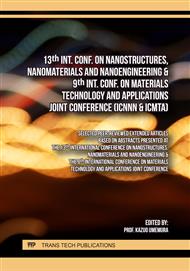[1]
Jackson PA, Rahman WNWA, Wong CJ, Ackerly T, Geso M. Potential dependent superiority of gold nanoparticles in comparison to iodinated contrast agents. Eur J Radiol 2010;75:104–9.
DOI: 10.1016/j.ejrad.2009.03.057
Google Scholar
[2]
Algethami M, Feltis B, Geso M. Bismuth Sulfide Nanoparticles as a Complement to Traditional Iodinated Contrast Agents at Various X-Ray Computed Tomography Tube Potentials. Journal of Nanomaterials & Molecular Nanotechnology 2017;06:2–10.
DOI: 10.4172/2324-8777.1000222
Google Scholar
[3]
Winter H, Brown AL, Goforth AM. Bismuth-Based Nano- and Microparticles in X-Ray Contrast, Radiation Therapy, and Radiation Shielding Applications. Bismuth - Advanced Applications and Defects Characterization, 2018, p.71–90.
DOI: 10.5772/intechopen.76413
Google Scholar
[4]
Dadashi S, Poursalehi R, Delavari H. Optical and structural properties of oxidation resistant colloidal bismuth/gold nanocomposite: An efficient nanoparticles based contrast agent for X-ray computed tomography. J Mol Liq 2018;254:12–9.
DOI: 10.1016/j.molliq.2018.01.069
Google Scholar
[5]
Dadashi S, Poursalehi R, Delavari H H. In situ PEGylation of Bi nanoparticles prepared via pulsed Nd:YAG laser ablation in low molecular weight PEG: a potential X-ray CT imaging contrast agent. Comput Methods Biomech Biomed Eng Imaging Vis 2019;7:420–7.
DOI: 10.1080/21681163.2018.1452634
Google Scholar
[6]
Eladio J. Rivera, Tran LA, Hernández-Rivera M, Yoon D, Mikos AG, Rusakova IA, et al. Bismuth@US-tubes as a Potential Contrast Agent for X-ray Imaging Applications. J Mater Chem B Mater Biol Med 2013;1:1–21.
DOI: 10.1039/c3tb20742k
Google Scholar
[7]
Ahamed M, Akhtar MJ, Khan MAM, Alrokayan SA, Alhadlaq HA. Oxidative stress mediated cytotoxicity and apoptosis response of bismuth oxide (Bi2O3) nanoparticles in human breast cancer (MCF-7) cells. Chemosphere 2019;216:823–31.
DOI: 10.1016/j.chemosphere.2018.10.214
Google Scholar
[8]
Szostak K, Ostaszewski P, Pulit-Prociak J, Banach M. Bismuth Oxide Nanoparticles in Drug Delivery Systems. Pharm Chem J 2019;53:48–51.
DOI: 10.1007/s11094-019-01954-9
Google Scholar
[9]
Rajaee A, Wang S, Zhao L. Bismuth-based nanoparticles as radiosensitizer in low and high dose rate brachytherapy. Polish Journal of Medical Physics and Engineering 2019;25:79–85.
DOI: 10.2478/pjmpe-2019-0011
Google Scholar
[10]
Xuan Y, Song XL, Yang XQ, Zhang RY, Song ZY, Zhao DH, et al. Bismuth particles imbedded degradable nanohydrogel prepared by one-step method for tumor dual-mode imaging and chemo-photothermal combined therapy. Chemical Engineering Journal 2019;375:122000.
DOI: 10.1016/j.cej.2019.122000
Google Scholar
[11]
Naha PC, Zaki A Al, Hecht E, Chorny M, Chhour P, Yates DM, et al. Dextran coated bismuth-iron oxide nanohybrid contrast agents for computed tomography and magnetic resonance imaging. J Mater Chem B Mater Biol Med 2014;2:8239–48. https://doi.org/.
DOI: 10.1039/C4TB01159G
Google Scholar
[12]
Abidin SZ, Zulkifli ZA, Razak KA, Zin H, Yunus MA, Rahman WN. PEG coated bismuth oxide nanorods induced radiosensitization on MCF-7 breast cancer cells under irradiation of megavoltage radiotherapy beams. Mater Today Proc 2019;16:1640–5.
DOI: 10.1016/j.matpr.2019.06.029
Google Scholar
[13]
Zulkifli ZA, Razak KA, Rahman WNWA, Abidin SZ. Synthesis and Characterisation of Bismuth Oxide Nanoparticles using Hydrothermal Method: The Effect of Reactant Concentrations and application in radiotherapy. J Phys Conf Ser 2018;1082:1–7.
DOI: 10.1088/1742-6596/1082/1/012103
Google Scholar
[14]
J Fu J, Guo J, Qin A, Yu X, Zhang Q, Lei X, et al. Bismuth chelate as a contrast agent for X - ray computed tomography. J Nanobiotechnology 2020;18:1–10.
DOI: 10.1186/s12951-020-00669-4
Google Scholar
[15]
Dong YC, Hajfathalian M, Maidment PSN, Hsu JC, Naha PC, Si-Mohamed S, et al. Effect of Gold Nanoparticle Size on Their Properties as Contrast Agents for Computed Tomography. Sci Rep 2019;9:1–13.
DOI: 10.1038/s41598-019-50332-8
Google Scholar
[16]
Brown AL, Naha PC, Benavides-Montes V, Litt HI, Goforth AM, Cormode DP. Synthesis, X-ray opacity, and biological compatibility of ultra-high payload elemental bismuth nanoparticle X-ray contrast agents. Chemistry of Materials 2014;26:2266–74.
DOI: 10.1021/cm500077z
Google Scholar
[17]
Mohammadi M, Khademi S, Choghazardi Y, Irajirad R, Keshtkar M, Montazerabadi A. Modified Bismuth Nanoparticles: A New Targeted Nanoprobe for Computed Tomography Imaging of Cancer. Cell J 2022;24:515–21.
Google Scholar
[18]
Rizzo R, Capozza M, Carrera C, Terreno E. Bi-HPDO3A as a novel contrast agent for X-ray computed tomography. Sci Rep 2023;13:1–8.
DOI: 10.1038/s41598-023-43031-y
Google Scholar
[19]
Shu G, Zhang C, Wen Y, Pan J, Zhang X, Sun SK. Bismuth drug-inspired ultra-small dextran coated bismuth oxide nanoparticles for targeted computed tomography imaging of inflammatory bowel disease. Biomaterials 2024;311:122658.
DOI: 10.1016/j.biomaterials.2024.122658
Google Scholar
[20]
Rezaei MR, Khoshgard K, Hosseinzadeh L, Haghparast A, Eivazi MT. Application of dextran-coated iron oxide nanoparticles in enhancing the radiosensitivity of cancerous cells in radiotherapy with high-energy electron beams. J Cancer Res Ther 2019.
DOI: 10.4103/jcrt.JCRT_19_17
Google Scholar
[21]
Davenport MS, Perazella MA, Yee J, Dillman JR, Fine D, McDonald RJ, et al. Use of Intravenous Iodinated Contrast Media in Patients With Kidney Disease: Consensus Statements from the American College of Radiology and the National Kidney Foundation. Kidney Med 2020;2:85–93.
DOI: 10.1016/j.xkme.2020.01.001
Google Scholar



